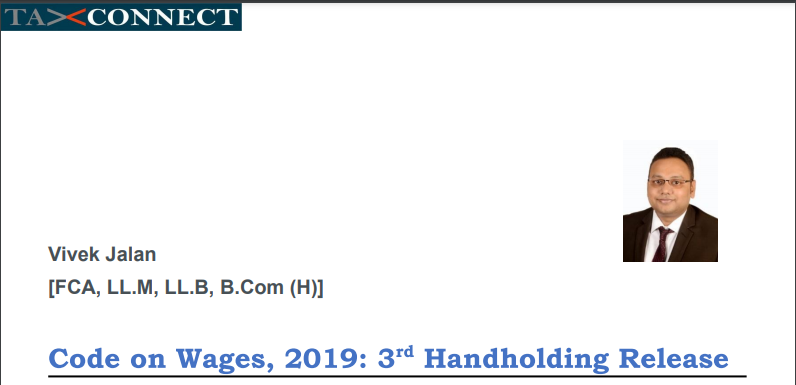Code on Wages, 2019: 3rd Handholding Release
The Code on Wages, 2019 subsumes Four Labour Laws, i.e. Payment Of Wages Act 1936, Minimum Wages Act 1948, Payment Of Bonus Act 1965 And Equal Remuneration Act 1976. This Code contains some important provisions which have far-reaching implications. These provisions are discussed herein.
Wage Code: Important Issues
- Appropriate Govt under Section 2(d)-
A. For Central Govt undertakings & PSUs – The appropriate Govt would be Central Govt.
B. For other Undertakings registered in 1 State – The appropriate Govt would be State Govt
C. For Multi-State Registered Undertakings – The appropriate Govt would be Central Govt.
TC Comments: Since Labour is a concurrent list subject, it is generally the confusion whether for the purpose of compliance an Organization would be accountable to ‘Central’ or ‘State’ Government. The term appropriate Government and the Codes clarify the said point.
- employee under Section 2k means –
A. Other than Apprentice
B. Employed to do Skilled, semi-skilled, unskilled job
C. Any type of Work including managerial or administrative
- A worker under Section 2z means –
A. Other than Apprentice
B. Employed to do Skilled, semi-skilled, unskilled job
C. Technical, operational, supervisory or clerical job
D. Not doing the managerial or administrative job
E. Doing Supervisory job and not drawing more than Rs.15000 per month.
TC Comments: Under Present Labour Laws, there is no clear distinction between Workmen and employees and sometimes it is seen that managerial staff also litigate with the employer organization contending that they are ‘workmen’. So, under Wage Code, Employees and Workers are distinguished. Now, Supervisory staff who are in the managerial and administrative role will not be classified as ‘workers’. Also, supervisory staff who are drawing more than Rs.15000 per month will not be classified as ‘worker’.
4A. Wages have been defined u/s 2y of The Wage Code. The same has been analyzed as under –
– Inclusions – Basic, Dearness Allowance & Retaining allowance
– Exclusions – Bonus, House accommodation, PF (plus Interest), Conveyance Allowance, HRA, Sum paid, Award, Overtime, Commission
Additional – Gratuity & Retrenchment
Provisio – Exclusions should be maximum of 50%
Explanation – Payment in kind up to 15% of “Total Wages” shall be deemed to a part of Wages.
4B. Deductions Sec 18(3) –
A. Cannot be more than 50% of the total Wages.
TC Comments: The following illustration would provide a clearer picture of this aspect along with the financial impact on the HR Cost for the Employer and the Cash in hand for the employee.
|
Particulars |
Current PF |
Prospective PF |
| Basic |
5,000 |
5,000 |
| Other allowances |
10,000 |
10,000 |
| Total Salary |
15,000 |
15,000 |
| PF Contribution | ||
| Employer |
600 |
750 |
| Employee |
600 |
750 |
| Total Deductions |
1,200 |
1,500 |
| Cash In Hand |
14,400 |
14,250 |
| % reduction in Cash In Hand |
-1% |
|
| CTC for Employer |
15,600 |
15,750 |
| % increase in CTC for Employer |
1% |
- Employer includes –
A. Manager of a factory
B. A person who has ultimate control like MD
C. Contractor
D. The legal representative of a deceased employer
Sec 43 requires that the employer shall be responsible to pay all amounts due.
TC Comments: Employer would thus mean the owner so to say including the MD of the Company. It is pertinent to note that in case of ‘every violation’ for non-payment of wages, the employer would be liable to a penalty and for repeated offence prosecution proceedings may be initiated also.
- Minimum Rate under Sec 6 & Sec 9 –
A. Central Govt will notify “Floor Rate”
B. State Govt can go above Floor Rate
TC Comments: This is an important provision whereby the floor rate for wages would be decided by The Central Government and State Governments may declare a higher rate but not a lower floor rate of wages.
- Overtime Rate (Sec 14 & 13) –
A. Double the normal rate
B. However, there should be an off day for every 7 day period
TC Comments: Important provision is that in every period of 7 days, the employer is duty-bound to provide a weekly off. Even on payment of the ‘overtime rate’ this weekly off is a statutory liability of the employer.
- Time Limit for Wages (Sec 17) –
A. 7th of the month –
B. In case of removed/dismissed/Retrenched employee – 2 working days
TC Comments: The time limit of 2 working days for payment of wages in case of removed/dismissed/Retrenched employee would be difficult to comply with.
- Facilitator Cum Inspector (Sec 51) –
A. Advise employers & Workers
B. Inspect, require documents, examine people, search, etc
C. His activities will be subject to IPC/CrPC
TC Comments: For ease of doing business, it is important that the Inspectors take informed judgements and facilitate business.
- Penalties & Offenses –
A. Pays less 1st Time – Fine Rs.50,000
B. Pays less next Time – Fine Rs.1,00,000 and prosecution
C. Commits any default 1st Time – Fine Rs.20,000
D. Commits any default next Time – Fine Rs.40,000 and prosecution
E. Non-maintenance of records – Rs.10000
TC Comments: Penalties are substantial in the Current Wage Code. However, prosecution provisions are less stringent.
Wage Code – Records, Returns & Notices – Section 50
The below-mentioned records are required to be maintained by the Employer:
- Employee Register
- Display on notice board –
A. Category wise wage rate
B. Wage period
C. Date & time of payment of wages
D. Name & Address of Facilitator Cum Inspector
3. Wage Slips
4. Proof of payment Noticing
Stages In Implementation Module of New Wage Code
To achieve seamless implementation of these Codes, they have to be done over a period of time, possibly 3months – 6 months. These stages should be further subdivided into phases with specific targets per phase. following are the stages along with different phases of Implementation of Labour Code Module:
STAGE I:
PHASE – I: Initial Training & Impact Analysis – This would involve calculating the “Impact” of the change in the cost to the company and the payment in the hands of the employees.
PHASE – II: Framing of Broad Guidelines – The broad guidelines as far as changing contracts and processes should be framed.
PHASE – III: ERP Change Management – The ERP Vendors would be required to be handheld to build in the legal aspects of these labour codes into their ERPs.
PHASE – IV: Going Live/ Revalidation – This would require that once the Labour Codes go live, the systems be checked and revalidated for assurance.
STAGE II: POST GOING LIVE MAINTAINANCE – The First 3 returns/ sets of compliances would be critical and the processes regarding the same needs to be reviewed. Also, there would be upteen no. of changes in the first few months which need to be continuously monitored.
TC Comments: For a Better Understanding of the provisions, readers may view the video embedded below.
The Video For The Above Article Can Be Accessed At The Following Link
LINK FOR THE VIDEO – https://youtu.be/0POkoDVRglk
If you already have a premium membership, Sign In.














